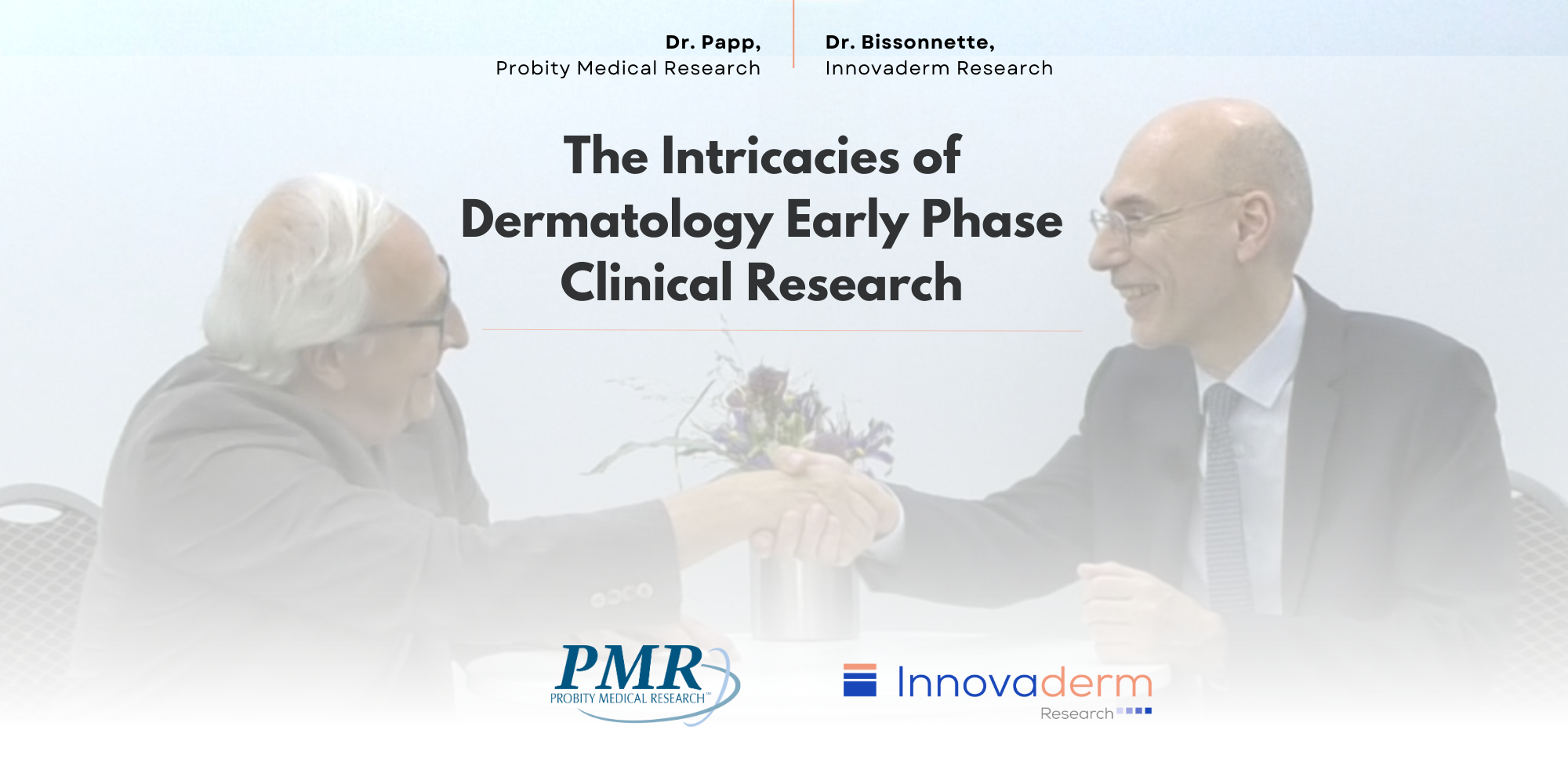Dr. Robert Bissonnette and Dr. Kim Papp on the Intricacies of Dermatology Early Phase Clinical Research

In collaboration with Probity Medical Research (PMR)
Amidst the bustling 2023 EADV in Berlin, Dr. Bissonnette from Innovaderm Research and Dr. Papp from Probity Medical Research (PMR) found a unique opportunity for an engaging conversation. The pair covered some of the main challenges encountered with conducting vitiligo studies and insights on alopecia areata (AA) studies. This article will focus on early phase studies.
New challenges— A Shift in Early Phase Studies’ Regulatory Standards
Dr. Kim Papp— It is important to highlight a specific challenge within the world of clinical research, particularly in early phase clinical trials. Considering the introduction of new molecules and conditions, how do you perceive these challenges?
While I can provide insights from my role as an investigator on the front lines, I am confident that you also face challenges from your perspective.
Dr. Robert Bissonnette— From the perspective of a Contract Research Organization (CRO), early phase studies present challenges some of which have surfaced more prominently in recent times. Notably, regulators are expressing difficulty, particularly in the context of systemic drugs like those involved in first-in-man studies. In the past, conducting single ascending dose and multiple ascending dose (SAD/MAD) studies in healthy volunteers seemed straightforward. Subsequently, partnering with dermatologists to recruit patients became a logical step, armed with safety information for specific doses over extended periods.
However, a shift in regulatory preferences has emerged: some authorities now advocate for SAD dermatology studies exclusively in healthy volunteers, while recommending that MAD studies be conducted directly in patients. This adjustment introduces complexities in identifying sites willing to undertake these studies and recruiting patients open to participating in phase 1b trials with novel compounds.
In light of these challenges, I am curious about your experiences with early phase clinical trials?
Regulatory Hurdles and Clinical Impact
Dr. Kim Papp— We observe a similar trend as we navigate the regulations across different countries, and it is evident that it is becoming a hurdle. Part of this challenge may stem from a lack of comprehension on the part of regulators regarding the true clinical impact. I believe this lack of understanding might be a collective oversight on our part, not fully grasping the level of disease severity necessary to detect a meaningful signal. Personally, I do not advocate attempting to extract every conceivable piece of information from an early phase study. It is an impractical endeavor due to constraints in time and resources.
Strategic Country Selection
Dr. Kim Papp— As you rightly pointed out, regulators hold significant sway. As long as regulators maintain a potentially misinformed stance, the struggle is likely to persist. Alternatively, companies may be compelled to explore other regions, not out of choice but out of necessity in response to the regulatory challenges.
Dr. Robert Bissonnette— In our capacity as a CRO, we strategically determine that certain types of studies are less than ideal for execution in the United States. The Canadian environment, in some instances, proves more conducive, and the clinical research landscape in Australia becomes particularly interesting depending on the study’s design. There are situations where we find it imperative to explore alternative locations.
Ideal Sites for Early Phase Studies
Dr. Robert Bissonnette— Another significant challenge lies in identifying sites interested and capable of recruiting for these early phase studies. One noteworthy advantage I perceive in a CRO collaborating with a substantial organization such as yours is the intimate knowledge of sites. Your organization possesses insights into which sites are likely to express interest and which have historically excelled in recruiting for similar studies.
Dr. Kim Papp— The site’s capacity is, in fact, a crucial consideration. Occasionally, a particular site may be overstretched, yet, from an investigator’s perspective, there is a desire to proceed. Therefore, one of our responsibilities is to manage and guide that enthusiasm, cautioning that the likelihood of success diminishes if the workload is taken on without due consideration. Unless alternative opportunities or support can be identified, taking on additional responsibilities might be a less favorable course of action.
In conclusion, early phase clinical research faces diverse challenges, including regulatory complexities, changing preferences, and the crucial issue of site capacity. As a CRO, Innovaderm Research addresses these challenges while demonstrating a strategic approach to selecting study locations. Collaborating with large organizations such as PMR can offer advantages, as their knowledge on site performance history and capacity for early phase studies can be leveraged.
Follow the link to gain access to the full interview.
Let’s shape the future of clinical research and make a difference in the industry, gain Innovaderm’s support in your upcoming trial and propel your study to new heights.
Newsletter
Newsletter subscription resources

